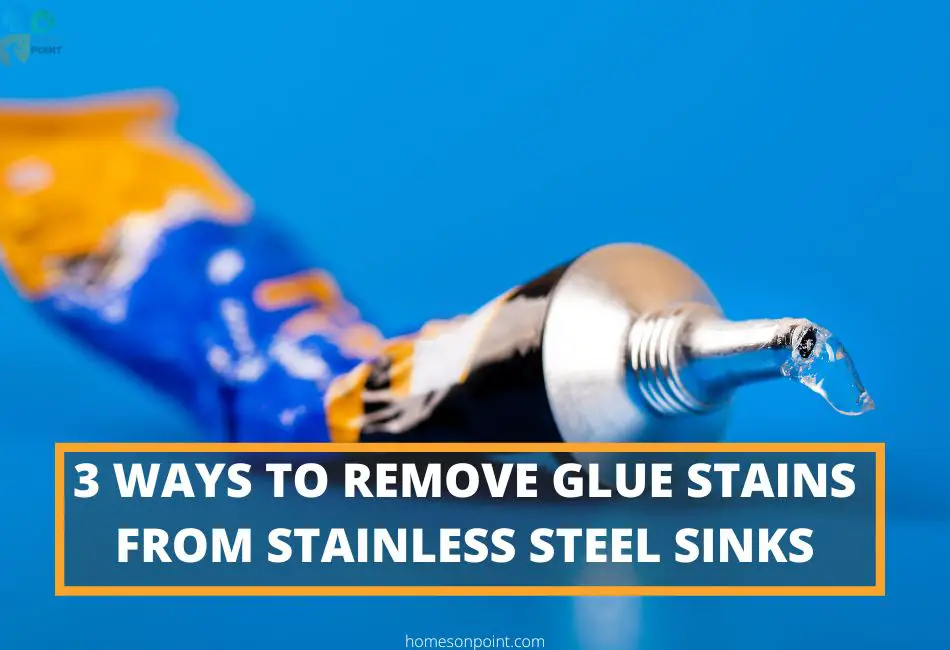We all know the primary function of glue, whether Super glue or Krazy glue, is to bond two surfaces together once it dries. What happens when you accidentally get some glue on your stainless steel sink while working on a project? Or when your child gets a little too creative and adventuristic with the glue bottle? Regardless of how the glue ended up on your sink, you’re now left with the challenge of removing it without damaging your sink’s finish.
Super glue contains an ingredient called cyanoacrylate. This is a strong adhesive that quickly bonds to surfaces and dries clear. While its instant bonding is great, it becomes annoying when it ends up on surfaces you don’t want it to, like your stainless steel sink because it will bond and harden almost instantly.
When super glue comes in contact with your sink, you cannot easily get rid of it with soap and water like other messes. You need a little extra effort to remove the glue without damaging your sink.
How To Remove Super Glue From Your Stainless Steel Sink
To remove super glue stains from your stainless steel sink, any of these 3 methods should work:
- Use acetone
- Use nail polish remover
- Lemon Juice and a plastic scraper
Let’s look at these methods in detail.
Using Acetone To Remove Super Glue From Stainless Steel Sink
When removing glued-on materials from stainless steel sink, acetone is often the go-to solution.
Acetone is a chemical solvent that is commonly used for dissolving and removing substances like adhesive residues. When applied to a glued surface, the acetone works to break down the chemical bonds that are holding the two surfaces together. This process can take a few minutes or longer depending on the type of glue involved. Once the bonds are broken, the adhesive material can then be easily wiped away.
In addition to its strong dissolving power, acetone is also effective at quickly evaporating off of surfaces. This property makes it ideal for use on stainless steel sinks where you don’t want to leave behind any sticky residue.
Because of its strength, acetone should be used with care when used on stainless steel sinks.
Materials Needed:
- Acetone
- Cotton balls
- Rag
- dish soap
Cleaning Instructions:
- Pour a small amount of acetone onto a cotton ball or swab. Acetone is a powerful solvent, so you only need to use a small amount. If you’re using a cotton ball, pour the acetone into a dish first so that you can control how much goes onto the ball. You don’t want to end up spilling acetone all over your sink.
- Dab the cotton ball onto the super glue stain. Allow the acetone to sit on the glue stain for a few minutes so that it can break down the adhesive. If the super glue is still not budging, try leaving the acetone on for a few more minutes. Do not use acetone on areas where there are no glue stains because you want to minimize any adverse effect the acetone will have on your sink.
- Wipe away the dissolved glue with a rag. Once the super glue has been broken down, you should be able to easily wipe it away with a rag. If there is still some residue left behind, you can repeat steps one and two until the stain is completely gone.
- When you’re finished, wash your sink with soap and water to remove any traces of acetone and dry it off with a clean rag.
Using Nail Polish Remover To Remove Super Glue From Stainless
Nail polish remover is a versatile household product that can be used for far more than just removing nail polish. It can also be used to remove glue from hard surfaces. The main active ingredient in nail polish remover is acetone, which as we have discussed in the previous section, it is a powerful solvent that can break down the bonds between surfaces.
Nail polish remover is slightly less potent than pure acetone, so it may take a little longer to work. However, it’s still an effective way to remove super glue from your stainless steel sink without damaging the finish.
Materials Needed:
- Nail Polish Remover
- Cotton balls
- Soft towel
- Dish soap
Cleaning Instructions:
- Pour a small amount of nail polish remover onto a cotton ball. Like with acetone, you only need to use a small amount of nail polish remover. You can apply more if needed, but it’s always better to start with less.
- Press the soaked cotton ball against the glue stain and allow the nail polish remover to sit on the glue until it starts dissolving.
- Once completely dissolved, use dish soap and a sponge to remove any nail polish remover residue and dry completely with a soft towel.
Using Lemon Juice And Plastic Scraper To Remove Super Glue From Stainless Steel Sink
Lemon juice is another household product that can be used to remove glue from surfaces. It is a more natural solution than using acetone or nail polish remover. The acidity in lemon juice will help cut through the glue and make it easier to remove with the plastic scraper. For best results, use freshly squeezed lemon juice rather than store-bought. Again, using lemon juice may not be as fast as acetone, but it will be less likely to damage your sink.
Things Needed:
- Freshly squeezed lemon juice
- Old toothbrush
- Plastic scraper
- Soft towel
Cleaning Instructions:
- Dip the old toothbrush into the freshly squeezed lemon juice and scrub the glue stain with it. The lemon juice will help break down the glue and the glue will begin to flake.
- Use the plastic scraper to scrape away as much of the glue as possible. You may need to go over the area a few times to get all of the glue off. Be careful not to scrape too hard or you could damage the stainless steel finish.
- Once all of the glue has been removed, rinse very well with clean water and use a soft towel to dry the area completely.
What You Shouldn’t Do When Removing Super Glue Stain From Your Stainless Steel Sink
There are a few things you should avoid doing when trying to remove super glue from your stainless steel sink.
1. Avoid Metal Or Abrasive Scrubbers
Never use a metal brush or abrasive scrubbers on your sink. This will damage the finish and leave behind scratches. Using metal scrubbers will end up causing permanent damage that the glue wouldn’t have done on its own. Always remember that stainless steel sinks can scratch.
Glue stains on your sink are just superficial and don’t warrant using aggressive cleaners that will damage your sink.
2. Avoid Using Sandpaper
Similar to using metal scrubbers, sandpaper is also too abrasive for use on your stainless steel sink. It will leave behind scratches and damage the finish. If you’re trying to remove glue from your sink, stick to using acetone, nail polish remover, or lemon juice. Sandpaper usage should be limited to removing extremely hard-to-go stains such as heavy rust on your stainless steel sink.
3. Avoid Knife Or Sharp Objects
Never try to scrape off dried glue with a knife or any other sharp object. It is very tempting to use a knife since it’s the first thing most people reach for when they need to remove something. But trust me, this is a bad idea. Many people fall into this trap and end up scratching the surface of their sink. When metal is used to scrape another metal, it leaves behind marks.
Similarly, do not use razor blades since they are also too sharp. If you accidentally slip, you could easily cut yourself on the razor blade. And we all know that trying to remove a super glue stain is not worth risking a trip to the emergency room.
4. Don’t Use Oven Cleaners
No matter how we think oven cleaners can help with removing super glue, it’s just not the case. Oven cleaners are very corrosive and will damage your stainless steel sink if used. It might remove the glue, but it will also eat away at your sink. So avoid using oven cleaners on your stainless steel sink at all costs.
Final Thoughts
That’s all there is to removing super glue stains from your stainless steel sink. By following the steps above, you can easily remove any glue stains without damaging your sink. Super glue in itself will not damage your stainless steel sink. It will only leave behind a superficial stain that can be easily removed. But if you are not careful the cleaning process will rather damage your sink. So avoid using metal scrubbers, sandpaper, or oven cleaners. And never try to scrape off the glue with a knife or any other sharp object. Thanks for reading and good luck.

